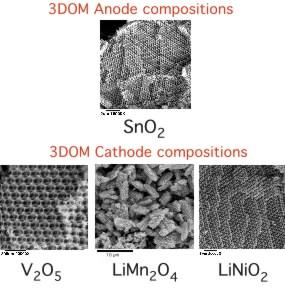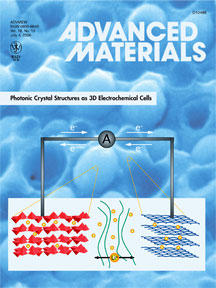3D-Nanostructured Battery Components
Development of small-footprint, high energy density batteries would permit construction of autonomous miniaturized devices (MEMS, actuators, sensors) without bulky external power supplies. State-of-the-art thin film Li+ batteries do not have the capacity per unit area necessary to supply the typical energy needed by a smart dust mote. Furthermore, conventional lithium secondary batteries experience large capacity losses during rapid charging or discharging. At high charging or discharging rates, fast lithium ion insertion at the surface and slow lithium ion transport within the electrode result in concentration polarization of lithium throughout the electrode material. This causes a rise or drop in battery voltage, which leads to termination of the charge or discharge before the maximum capacity of the electrode material is utilized. A revolutionary improvement can be effected by altering the battery geometry from 2D to 3D and by incorporating nanostructure features in the electrode architecture. In work funded by an ONR MURI program, we have developed macroporous electrode structures based on colloidal crystal templating. In these materials, charge-transport occurs on a nanometer scale, rather than a micrometer scale to reduce diffusion paths for charge carriers, diffusion polarization, and thereby charging times. Construction of such materials is possible via colloidal crystal templating methods to produce periodic macroporous structures of each battery component. We have prepared several electrode compositions with 3D ordered macroporous (3DOM) structure, including 3DOM cathode materials (LiMn2O4, LiCoO2, LiNiO2, V2O5) and anode materials (C, lithiated SnO2). We have demonstrated significant charge/discharge rate advantages due to the porous electrode architecture with submicrometer pores. 3D porous electrodes for lithium batteries have the potential for significantly enhancing geometric capacities (capacities per unit area). A nanoarchitectured cell design offers relatively large power densities and small geometrical footprints, providing the opportunity for significant gains for small systems. We are currently developing methods of integrating electrode and electrolyte components within a 3D interpenetrating structure. In addition to studying the effects of the unique material structure on electrochemical properties, we are addressing fundamental issues of crystallization/polymerization within the confinement of macropores.

